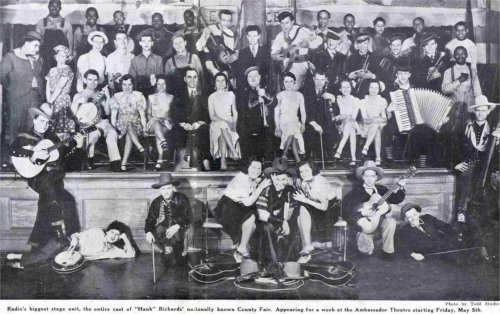Radio Articles
Was There A Radio Studio In This Building?

The question came in a phone call in October, 2004. David Ohlemeyer’s company, The Lawrence Group, was in the process of rehabbing St. Louis’ Marquette Building. Atop the building, an extra room had been built, and there was also a huge radio tower on the roof.
Ohlemeyer had found some papers and wanted to know, just out of curiosity, whether a radio station had operated there. Since the place was filled with construction workers and the elevators were out of order, a 20-story climb was in order.
Sure enough, the room he had talked about looked like it had been used as a studio. There were even a few perforated acoustical tiles still on the wall. But no documentation could be found to link a station to a studio here.
Those papers he’d found were a gold mine. They were bills of sale for the tower and its antenna, made out to Thomas Patrick, Inc. at the Chase Hotel, which was the parent company of KWK. The tower, purchased in December of 1946, was 270 feet tall. When erected, the tower’s top light was 574 feet above street level, making it the highest broadcast tower in the area. But the antenna to be installed on the tower was for an FM station. KWK was an AM station.
All of the equipment was delivered to 314 North Broadway, then known as the Boatmen’s Bank Building. Thomas Patrick, Inc., had been given permission in 1945 to erect an FM station on a frequency of 95.3 megacycles. The station came on the air in September of 1946, so this tower would not have been in use initially.
The Federal Communications Commission changed KWK-FM’s frequency to 99.1 the following year. The change appears to have come in August, 1947, thus bringing the new tower into use. But the mystery of the studio remains unclear.
In October 1946, an article in the Globe-Democrat told of KWK’s purchase of a two-story former bank building at the corner of Fourth and Pine streets downtown, a block away from the then Boatmen’s Bank Building. The article stated “One of the most modern broadcasting studios in the Midwest has been planned” for the building.
But the best-laid plans failed to become reality. For unknown reasons, the building was never refurbished. Three years later, May 9, 1949, KWK-AM and FM moved their studios to the building at Twelfth and Cole where the Globe-Democrat’s FM station KWGD was being shut down. At the same time, the company that owned KWK and KWK-FM changed its name to KWK, Inc.
The new building had its own broadcast tower on site, rendering the tower atop the Boatmen’s Building redundant. By the end of the year, the St. Louis Star-Times entered into an agreement to buy and use the tower on The Boatmen’s Building for its station, KXOK-FM.
There was never a mention of permanent studios at the Broadway address but an interview many years later provided an explanation. KCFM was broadcasting from the tower after a disastrous fire destroyed their facilities, and owner Harry Eidelman made reference to the fact that his announcers were using the “temporary studio on the 22nd floor of the Boatmen’s Bank building.”
The temporary studio had been put in place after construction of the tower so the radio station would have a place to originate broadcasts in such an emergency.
(Reprinted with permission of the St. Louis Journalism Review. Originally published 1/2009).



